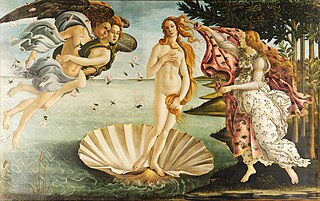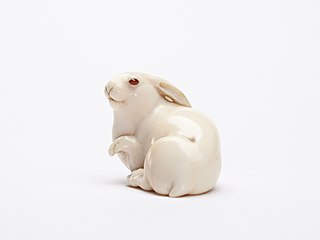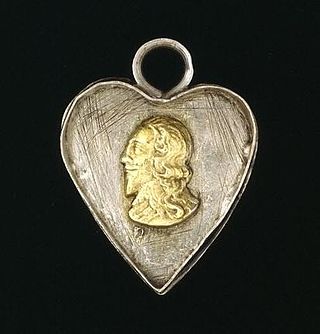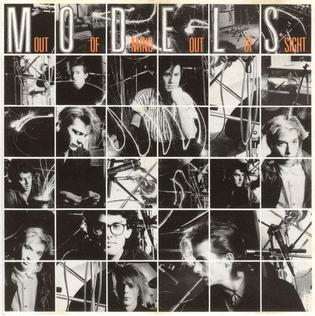
A bead is a small, decorative object that is formed in a variety of shapes and sizes of a material such as stone, bone, shell, glass, plastic, wood, or pearl and with a small hole for threading or stringing. Beads range in size from under 1 millimetre (0.039 in) to over 1 centimetre (0.39 in) in diameter.

A seashell or sea shell, also known simply as a shell, is a hard, protective outer layer usually created by an animal or organism that lives in the sea. The shell is part of the body of the animal. Empty seashells are often found washed up on beaches by beachcombers. The shells are empty because the animal has died and the soft parts have decomposed or been eaten by another animal.

The Birth of Venus is a painting by the Italian artist Sandro Botticelli, probably executed in the mid 1480s. It depicts the goddess Venus arriving at the shore after her birth, when she had emerged from the sea fully-grown. The painting is in the Uffizi Gallery in Florence, Italy.

A netsuke is a miniature sculpture, originating in 17th century Japan. Initially a simply-carved button fastener on the cords of an inrō box, netsuke later developed into ornately sculpted objects of craftsmanship.

Macramé is a form of textile produced using knotting techniques.

A greeting card is a piece of card stock, usually with an illustration or photo, made of high quality paper featuring an expression of friendship or other sentiment. Although greeting cards are usually given on special occasions such as birthdays, Christmas or other holidays, such as Halloween, they are also sent to convey thanks or express other feelings.

Scrimshaw is scrollwork, engravings, and carvings done in bone or ivory. Typically it refers to the artwork created by whalers, engraved on the byproducts of whales, such as bones or cartilage. It is most commonly made out of the bones and teeth of sperm whales, the baleen of other whales, and the tusks of walruses.

A gift shop or souvenir shop is a store primarily selling souvenirs, memorabilia, and other items relating to a particular topic or theme. The items sold often include coffee mugs, stuffed animals, toys, t-shirts, postcards, handmade collections and other souvenirs, intended to be kept by the buyer as a memento of their visit, or given to another as a gift.

A locket is a pendant that opens to reveal a space used for storing a photograph or other small item such as a lock of hair. Lockets are usually given to loved ones on holidays such as Valentine's Day and occasions such as christenings, weddings and, most noticeably during the Victorian Age, funerals. Historically, they often opened to reveal a portrait miniature.

Alaska Native cultures are rich and diverse, and their art forms are representations of their history, skills, tradition, adaptation, and nearly twenty thousand years of continuous life in some of the most remote places on earth. These art forms are largely unseen and unknown outside the state of Alaska, due to distance from the art markets of the world.

Commercial whaling in the United States dates to the 17th century in New England. The industry peaked in 1846–1852, and New Bedford, Massachusetts, sent out its last whaler, the John R. Mantra, in 1927. The Whaling industry was engaged with the production of three different raw materials: whale oil, spermaceti oil, and whalebone. Whale oil was the result of "trying-out" whale blubber by heating in water. It was a primary lubricant for machinery, whose expansion through the Industrial Revolution depended upon before the development of petroleum-based lubricants in the second half of the 19th century. Once the prized blubber and spermaceti had been extracted from the whale, the remaining majority of the carcass was discarded.

Out of Mind, Out of Sight is the fourth studio album by Australian new wave rock band Models, it was their most successful album and peaked at No. 3 on the Australian albums chart. It was released in August 1985 by Mushroom Records with Nick Launay, Reggie Lucas and Mark Opitz producing.

Variety Unit is an exhibit building at Shelburne Museum in Shelburne, Vermont.

Licitars are colorfully decorated biscuits made of sweet honey dough that are part of Croatia and Slovenia's cultural heritage. They are a traditional symbol of the Croatian capital Zagreb. They are used as an ornamental gift, often given at celebrations of love such as weddings and Valentine's Day. At Christmas time, the city of Zagreb and the Christmas tree in the main square in particular are festooned with thousands of licitar hearts.

The Early American Industries Association (EAIA) was founded in 1933 by a group of people interested in the traditional trades and crafts of early America. They met to discuss the rapidly disappearing practitioners of these trades, including those of the shop, farm, sea, and home. They were concerned about the loss of the skills and knowledge of the tools and practices of those trades and wanted to do something to preserve them. Their solution was the formation of the EAIA, subsequently incorporated on March 16, 1942, as a nonprofit educational organization interested in all aspects of the mechanical arts in America.
The conservation and restoration of ivory objects is the process of maintaining and preserving objects that are ivory or include ivory material. Conservation and restoration are aimed at preserving the ivory material and physical form along with the objects condition and treatment documentation. Activities dedicated to the preservation of ivory objects include preventing agents of deterioration that specifically connect with ivory as a material, preventative conservation, and treatment of ivory objects. Conservators, curators, collections managers, and other museum personnel are in charge of taking the necessary measurements to ensure that ivory objects are well maintained and will make the decision for any conservation and restoration of the objects.

Sailor tattoos are traditions of tattooing among sailors, including images with symbolic meanings. These practices date back to at least the 16th century among European sailors, and since colonial times among American sailors. People participating in these traditions have included military service members in national navies, seafarers in whaling and fishing fleets, and civilian mariners on merchant ships and research vessels. Sailor tattoos have served as protective talismans in sailors' superstitions, records of important experiences, markers of identity, and means of self-expression. Common symbols include swallows, nautical stars, and anchors.

Shellcraft, also known as shell craft, is the craft of making decorative objects, or of decorating surfaces, using seashells. The craft includes the design and creation of small items such as shell jewelry and figurines made from shells; middle-sized objects such as boxes and mirror frames covered in shells; sailor's valentines; and larger constructions including mosaics and shell grottos.

A shell purse is a type of coin purse that is made from whole or trimmed mollusk shells, especially from bivalve mollusc shells. These purses are of mainly novelty use and purchased as souvenirs of visits, etc. In the past, some were engraved or painted with floral or other decorations, sentimental messages, personal or place names. In many cases there was extra working of the shell, either grinding down and polishing to expose the mother of pearl or filing to form patterns such as criss-cross designs.

Culture consists of the social behaviour and norms in human societies transmitted through social learning. Molluscs play a variety of roles in culture, including but not limited to art and literature, with both practical interactions—whether useful or harmful—and symbolic uses.




















